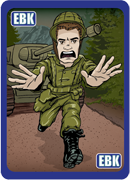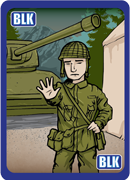Blockade and Emergency Blockade Cards: Difference between revisions
No edit summary |
m simplify extra fields on card infoboxes |
||
| (14 intermediate revisions by 5 users not shown) | |||
| Line 1: | Line 1: | ||
https://www.warlight.net/Images/AbandonHelp.png | |||
The | The blockade and emergency blockade cards change one of your territories to a [[neutral]] and multiply the number of armies on that territory by a predefined factor, usually increasing it. They're useful for creating a defensive blockade, among other uses. Since the armies on the territory you select are changing into neutral armies, you are essentially permanently losing control of the armies on that territory. | ||
= | == Emergency Blockade Card == | ||
<table> | |||
<tr> | |||
<td style="vertical-align: top; width: 100%;"> | |||
Emergency Blockade cards are played after deployments but before any attacks happen. This means you can deploy armies to a territory in the same turn in which you blockade it to help the card have maximum effect. | |||
Examples of use: | Examples of use: | ||
* If a chokepoint exists just outside of your bonus, and you don't plan on expanding in that direction soon, you can place a large army there and | * If a chokepoint exists just outside of your bonus, and you don't plan on expanding in that direction soon, you can place a large army there and blockade it. This will create a nice barrier for opponents, such as in the Alaska picture above. | ||
* If you have a foothold in a neighboring bonus but you don't want to take it, you can make a large neutral in it to discourage opponents from wanting that bonus - similar to a wasteland. | * If you have a foothold in a neighboring bonus but you don't want to take it, you can make a large neutral in it to discourage opponents from wanting that bonus - similar to a wasteland. | ||
* If you know that an opponent will attack you next turn, and you know that you will probably lose or come close to losing, you can take significantly more armies away from that opponent by | * If you know that an opponent will attack you next turn, and you know that you will probably lose or come close to losing, you can take significantly more armies away from that opponent by blockading the territory they are attacking. However, if you are wrong and they do not attack, they will then see that it's neutral and can decide to leave it alone - essentially wasting your armies. | ||
</td> | |||
=Blockade Card= | <td style="vertical-align: top;">{{Card infobox | ||
|name=Emergency Blockade Card | |||
The blockade card works similarly to the | |img=https://warzonecdn.com/ujs/Resources/EmergencyBlockade.png | ||
|extra={{Card infobox/row|Multiplier}} | |||
}} | |||
</td> | |||
</tr> | |||
</table> | |||
== Blockade Card == | |||
<table> | |||
<tr> | |||
<td style="vertical-align: top; width: 100%;">The blockade card works similarly to the emergency blockade card, however it is less effective. Instead of happening at the beginning of your turn, it happens at the end. This means any attacks, [[airlifts]], or other actions happen before the territory changes into a neutral and increases its armies. | |||
The advantage of using the blockade card in lieu of the | The advantage of using the blockade card in lieu of the emergency blockade card in your games means that, on offense, you won't have to worry about your large stacks getting devastated. Since the blockades happen after attacks, your offensive stacks can freely move around without hitting any unexpected blockades. | ||
The blockade card is a little more difficult to use than the emergency blockade card. When playing a blockade card, it's very important to ensure you still own the territory you're blockading at the end of your turn. If you lose the territory you played the card on, the card will have no effect and you don't get the card back. Therefore, it's recommended that you play this on territories that you know you won't lose, such as those that don't touch an opponent or that are sufficiently defended. | |||
Unlike the | Unlike the emergency blockade card, you can move armies into the territory you played a blockade card on in the same turn, either via a normal transfer or via airlift. These armies will then be able to take part in the blockade, and increase the resulting blockade size even further. | ||
</td> | |||
<td style="vertical-align: top;"> | |||
{{Card infobox | |||
|name=Blockade Card | |||
|img=https://warzonecdn.com/ujs/Resources/BlockadeCard.png | |||
|extra={{Card infobox/row|Multiplier}} | |||
}} | |||
</td> | |||
</table> | |||
== Rounding == | |||
If the resulting neutral size does not come out evenly, it will be rounded to the nearest whole number. If the remainder is exactly 0.5, it will be rounded down. | |||
=See | == See also == | ||
* [[Cards]] | * [[Cards]] | ||
{{Cards}} | |||
[[Category:Cards]] | |||
Latest revision as of 23:13, 21 January 2025

The blockade and emergency blockade cards change one of your territories to a neutral and multiply the number of armies on that territory by a predefined factor, usually increasing it. They're useful for creating a defensive blockade, among other uses. Since the armies on the territory you select are changing into neutral armies, you are essentially permanently losing control of the armies on that territory.
Emergency Blockade Card
|
Emergency Blockade cards are played after deployments but before any attacks happen. This means you can deploy armies to a territory in the same turn in which you blockade it to help the card have maximum effect. Examples of use:
|
Emergency Blockade Card 
|
Blockade Card
| The blockade card works similarly to the emergency blockade card, however it is less effective. Instead of happening at the beginning of your turn, it happens at the end. This means any attacks, airlifts, or other actions happen before the territory changes into a neutral and increases its armies.
The advantage of using the blockade card in lieu of the emergency blockade card in your games means that, on offense, you won't have to worry about your large stacks getting devastated. Since the blockades happen after attacks, your offensive stacks can freely move around without hitting any unexpected blockades. The blockade card is a little more difficult to use than the emergency blockade card. When playing a blockade card, it's very important to ensure you still own the territory you're blockading at the end of your turn. If you lose the territory you played the card on, the card will have no effect and you don't get the card back. Therefore, it's recommended that you play this on territories that you know you won't lose, such as those that don't touch an opponent or that are sufficiently defended. Unlike the emergency blockade card, you can move armies into the territory you played a blockade card on in the same turn, either via a normal transfer or via airlift. These armies will then be able to take part in the blockade, and increase the resulting blockade size even further. |
Blockade Card 
|
Rounding
If the resulting neutral size does not come out evenly, it will be rounded to the nearest whole number. If the remainder is exactly 0.5, it will be rounded down.